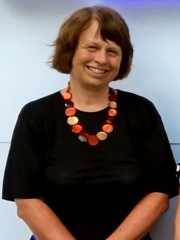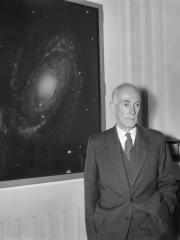
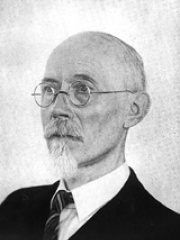
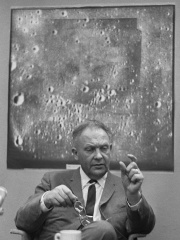
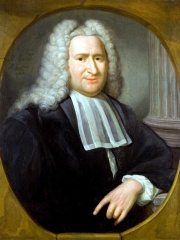
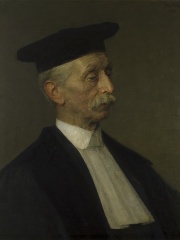

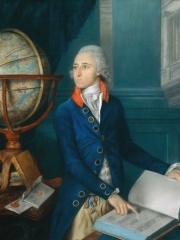
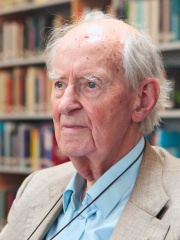
The Most Famous
ASTRONOMERS from Netherlands
This page contains a list of the greatest Dutch Astronomers. The pantheon dataset contains 644 Astronomers, 21 of which were born in Netherlands. This makes Netherlands the birth place of the 7th most number of Astronomers behind Italy, and Japan.
Top 10
The following people are considered by Pantheon to be the top 10 most legendary Dutch Astronomers of all time. This list of famous Dutch Astronomers is sorted by HPI (Historical Popularity Index), a metric that aggregates information on a biography's online popularity. Visit the rankings page to view the entire list of Dutch Astronomers.

1. Jan Oort (1900 - 1992)
With an HPI of 71.29, Jan Oort is the most famous Dutch Astronomer. His biography has been translated into 59 different languages on wikipedia.
Jan Hendrik Oort ( or ; 28 April 1900 – 5 November 1992) was a Dutch astronomer who made significant contributions to the understanding of the Milky Way and who was a pioneer in the field of radio astronomy. The New York Times called him "one of the century's foremost explorers of the universe"; the European Space Agency website describes him as "one of the greatest astronomers of the 20th century" and states that he "revolutionised astronomy through his ground-breaking discoveries." In 1955, Oort's name appeared in Life magazine's list of the 100 most famous living people. He has been described as "putting the Netherlands in the forefront of postwar astronomy". Oort determined that the Milky Way rotates and overturned the idea that the Sun was at its center. He also analyzed the vertical motions of stars near the Sun, using this data to estimate the local gravitational field. He calculated how much mass must be present to account for the stellar motions perpendicular to the Galactic plane. Comparing this mass to the visible stars and gas, in 1932, he wrote, "This leads to the conclusion that there must be considerable amounts of invisible matter." The following year, Fritz Zwicky called this invisible matter “dunkle Materie”, German for dark matter. It is now believed that dark matter makes up approximately 84.5% of the total mass in the Universe, and its gravitational pull is responsible for "the clustering of stars into galaxies and galaxies into connecting strings of galaxies". However, Oort's data have been challenged and his discovery may have been spurious. Oort discovered the galactic halo, a group of stars orbiting the Milky Way but outside the main disk. Additionally Oort is responsible for a number of important insights about comets, including the realization that their orbits "implied there was a lot more solar system than the region occupied by the planets." The Oort cloud, the Oort constants, Oort Limit, an impact crater on Pluto (Oort), and the asteroid 1691 Oort were all named after him.

2. Antonie Pannekoek (1873 - 1960)
With an HPI of 71.01, Antonie Pannekoek is the 2nd most famous Dutch Astronomer. His biography has been translated into 30 different languages.
Antonie "Anton" Pannekoek (Dutch: [ˈɑntɔn ˈpɑnəkuk]; 2 January 1873 – 28 April 1960) was a Dutch astronomer, historian, philosopher, Marxist theorist, and socialist revolutionary. He was one of the main theorists of council communism (Dutch: radencommunisme).

3. Gerard Kuiper (1905 - 1973)
With an HPI of 70.97, Gerard Kuiper is the 3rd most famous Dutch Astronomer. His biography has been translated into 60 different languages.
Gerard Peter Kuiper ( KY-pər; born Gerrit Pieter Kuiper, Dutch: [ˈɣɛrɪt ˈpitər ˈkœypər]; 7 December 1905 – 23 December 1973) was a Dutch astronomer, planetary scientist, selenographer, author and professor. The Kuiper belt is named after him. Kuiper is considered by many to be the father of modern planetary science.

4. Pieter van Musschenbroek (1692 - 1761)
With an HPI of 69.21, Pieter van Musschenbroek is the 4th most famous Dutch Astronomer. His biography has been translated into 36 different languages.
Pieter van Musschenbroek (14 March 1692 – 19 September 1761) was a Dutch scientist. He was a professor in Duisburg, Utrecht, and Leiden, where he held positions in mathematics, philosophy, medicine, and astronomy. He is credited with the invention of the first capacitor in 1746: the Leyden jar. He performed pioneering work on the buckling of compressed struts. Musschenbroek was also one of the first scientists (1729) to provide detailed descriptions of testing machines for tension, compression, and flexure testing. An early example of a problem in dynamic plasticity was described in the 1739 paper (in the form of the penetration of butter by a wooden stick subjected to impact by a wooden sphere).
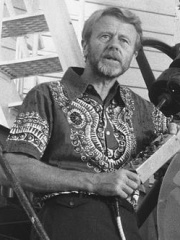
5. Tom Gehrels (1925 - 2011)
With an HPI of 68.50, Tom Gehrels is the 5th most famous Dutch Astronomer. His biography has been translated into 41 different languages.
Anton Marie Jacob "Tom" Gehrels (February 21, 1925 – July 11, 2011) was a Dutch–American astronomer, Professor of Planetary Sciences, and Astronomer at the University of Arizona, Tucson.

6. Jacobus Kapteyn (1851 - 1922)
With an HPI of 65.86, Jacobus Kapteyn is the 6th most famous Dutch Astronomer. His biography has been translated into 36 different languages.
Jacobus Cornelius Kapteyn (19 January 1851 – 18 June 1922) was a Dutch astronomer. He carried out extensive studies of the Milky Way. He found that the apparent movement of stars was not randomly distributed but had two preferential directions: the two star streams. This discovery was later reinterpreted as evidence for galactic rotation. Kapteyn also suggested that these stellar velocities could be used to find the amount of non-luminous matter in the galaxy, which his student, Jan Oort, measured in 1932, referring to it as "invisible matter".

7. Cornelis Johannes van Houten (1920 - 2002)
With an HPI of 65.44, Cornelis Johannes van Houten is the 7th most famous Dutch Astronomer. His biography has been translated into 33 different languages.
Cornelis Johannes "Kees" van Houten (18 February 1920 – 24 August 2002) was a Dutch astronomer.

8. John Goodricke (1764 - 1786)
With an HPI of 65.44, John Goodricke is the 8th most famous Dutch Astronomer. His biography has been translated into 36 different languages.
John Goodricke FRS (17 September 1764 – 20 April 1786) was an English amateur astronomer. He is best known for his observations of the variable star Algol (Beta Persei) in 1782.

9. Adriaan Blaauw (1914 - 2010)
With an HPI of 64.65, Adriaan Blaauw is the 9th most famous Dutch Astronomer. His biography has been translated into 24 different languages.
Adriaan Blaauw (12 April 1914 – 1 December 2010) was a Dutch astronomer. Blaauw was born in Amsterdam to Cornelis Blaauw and Gesina Clasina Zwart, and studied at Leiden University and the University of Groningen, obtaining his doctorate at the latter in 1946. In 1948, he was appointed an associate professor at Leiden. In the 1950s he worked a few years at the Yerkes Observatory, before returning to Europe in 1957 to become director of the Kapteyn Astronomical Institute in Groningen. Blaauw was closely involved in the founding of the European Southern Observatory, and was its general director from 1970 to 1975. In 1975, he returned to the Netherlands, becoming a full professor at Leiden, until his retirement in 1981. From 1976 to 1979, he served as president of the International Astronomical Union. He chaired the committee for assigning scientific priorities for the observing programme of the astrometric satellite Hipparcos. His research has involved star formation, the motions of star clusters and stellar associations, and distance scale. His main contributions are the explanation of the origin of stars that move with high velocity in our galaxy and the description of star formation in associations. Among his many honours he was made member of the Royal Netherlands Academy of Arts and Sciences in 1963, elected a Foreign Honorary Member of the American Academy of Arts and Sciences in 1973. In 1989, he was awarded the Bruce Medal. In 1997, the University of Groningen instituted a Blaauw chair and Blaauw lecture in his honour. The asteroid 2145 Blaauw and the Blaauw Observatory are named after him. He died in 2010 in the city of Groningen.
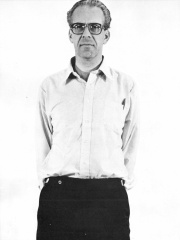
10. Maarten Schmidt (1929 - 2022)
With an HPI of 60.40, Maarten Schmidt is the 10th most famous Dutch Astronomer. His biography has been translated into 22 different languages.
Maarten Schmidt (28 December 1929 – 17 September 2022) was a Dutch-born American astronomer who first measured the distances of quasars. He was the first astronomer to identify a quasar, and so was pictured on the March cover of Time magazine in 1966.
People
Pantheon has 21 people classified as Dutch astronomers born between 1598 and 1955. Of these 21, 2 (9.52%) of them are still alive today. The most famous living Dutch astronomers include Walter Lewin, and Ewine van Dishoeck. The most famous deceased Dutch astronomers include Jan Oort, Antonie Pannekoek, and Gerard Kuiper.
Living Dutch Astronomers
Go to all RankingsDeceased Dutch Astronomers
Go to all RankingsJan Oort
1900 - 1992
HPI: 71.29
Antonie Pannekoek
1873 - 1960
HPI: 71.01
Gerard Kuiper
1905 - 1973
HPI: 70.97
Pieter van Musschenbroek
1692 - 1761
HPI: 69.21
Tom Gehrels
1925 - 2011
HPI: 68.50
Jacobus Kapteyn
1851 - 1922
HPI: 65.86
Cornelis Johannes van Houten
1920 - 2002
HPI: 65.44
John Goodricke
1764 - 1786
HPI: 65.44
Adriaan Blaauw
1914 - 2010
HPI: 64.65
Maarten Schmidt
1929 - 2022
HPI: 60.40
Hendrik van Gent
1900 - 1947
HPI: 59.96
Michael van Langren
1598 - 1675
HPI: 59.94
Overlapping Lives
Which Astronomers were alive at the same time? This visualization shows the lifespans of the 17 most globally memorable Astronomers since 1700.


